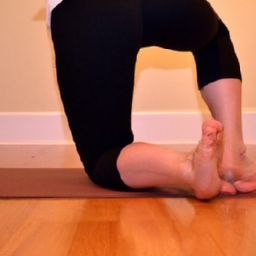Have you ever wondered how often you should practice yoga? It’s a common question for both beginners and experienced yogis alike. Finding the right balance between consistency and rest is key to obtaining the maximum benefits from your practice. In this article, we’ll dive into the different factors to consider when determining how often you should roll out your mat. By the end, you’ll have a better understanding of what works best for your body and can make an informed decision about your yoga practice.
When it comes to the frequency of your yoga practice, it really depends on your personal goals, schedule, and current fitness level. Some individuals may benefit from practicing yoga every day, while others might find three to four times a week to be more suitable. It’s important to listen to your body and not push yourself too hard. If you’re new to yoga, starting with two to three sessions per week can help you build strength and flexibility without overwhelming your body. And if you’re already a seasoned yogi, you might find that a more intensive daily practice aligns with your goals. So, get ready to explore the different options and discover how often you should practice yoga to enhance your well-being.
The Benefits of Regular Yoga Practice
Many individuals are discovering the numerous benefits of incorporating yoga into their daily routine. Whether you are a beginner or an advanced practitioner, regular yoga practice can lead to improved physical and mental well-being. In this article, we will explore the benefits of a consistent yoga practice and provide recommendations on how often you should practice based on your experience level and goals, physical and mental health condition, as well as available time and resources.
Improved flexibility and strength
One of the most well-known benefits of yoga is improved flexibility and strength. Through regular practice, you can gradually increase your range of motion, allowing you to move more freely and comfortably. In addition, yoga poses and sequences require the engagement of various muscle groups, leading to increased strength and toned muscles. Whether you are aiming to touch your toes for the first time or want to strengthen your core, consistent yoga practice can help you achieve these goals.
Reduced stress and anxiety
In today’s fast-paced world, stress and anxiety have become increasingly common. Fortunately, yoga provides an effective means of relieving these burdens. The combination of deep breathing techniques, mindful movements, and meditation cultivates a sense of calm and relaxation. Regular yoga practice can lower cortisol levels, the hormone responsible for stress, and promote the release of endorphins, the body’s natural “feel-good” chemicals. By dedicating time to your mat, you can release tension and find inner peace amidst the chaos of daily life.
Increased mindfulness and focus
In addition to physical benefits, yoga also enhances mental well-being. The practice of yoga encourages mindfulness, which involves being fully present in the moment and non-judgmentally observing your thoughts and sensations. By focusing on your breath and body during yoga poses, you cultivate a sense of awareness and improve your ability to concentrate. This increased mindfulness and focus can have a positive impact on various aspects of your life, such as work, relationships, and self-care.
Factors to Consider when Determining Frequency
When determining how often you should practice yoga, several factors come into play. These factors include your experience level and goals, physical and mental health condition, as well as available time and resources. Understanding these factors will help you establish a practice frequency that is sustainable and tailored to your individual needs.
Experience level and goals
If you are a beginner, it is recommended to start with 2-3 yoga sessions per week. This frequency allows your body to adapt to the new movements and build strength gradually. As you become more comfortable and confident in your practice, you can consider gradually increasing the frequency to daily sessions. For intermediate practitioners, 3-4 yoga sessions per week are generally recommended. This frequency provides a balance between maintaining progress and preventing burnout. Advanced practitioners, on the other hand, can benefit from practicing yoga 5-7 times per week. This frequency allows for exploration of different yoga styles and intensities, further deepening their practice.
Physical and mental health condition
Another important factor to consider when determining your yoga practice frequency is your physical and mental health condition. If you have any pre-existing medical conditions or injuries, it is essential to consult with your healthcare provider or a qualified yoga teacher before starting or increasing your practice. They can provide guidance on modifications or specific practices that suit your needs. Additionally, if you are experiencing high levels of stress, anxiety, or depression, increasing your practice frequency may be beneficial in managing these conditions. However, it is important to listen to your body and seek professional support if needed.
Available time and resources
Time constraints and the availability of resources can also impact your yoga practice frequency. If you have a busy schedule, finding time for regular yoga sessions can be challenging. In such cases, it is important to prioritize your well-being and make yoga a non-negotiable part of your daily routine. You can start by dedicating shorter sessions, such as 15-20 minutes, and gradually increase the duration as you find more time. Additionally, if attending yoga classes is not feasible due to location or financial constraints, there are various online platforms and resources that offer guided yoga practices at different levels.
Recommended Frequency for Beginners
For beginners, 2-3 times per week is a recommended starting point. This frequency allows you to gradually build physical strength and flexibility, as well as become familiar with the foundational yoga poses and techniques. By practicing a few times a week, you give your body enough time to rest and recover while still making progress. As you gain more confidence and feel comfortable with the poses, you can increase your practice frequency to daily sessions. However, it is important to listen to your body and not push yourself beyond your limits.
Recommended Frequency for Intermediate Practitioners
Once you have established a foundation in yoga, you can increase your practice frequency to 3-4 times per week. This frequency allows for consistent progress and allows you to challenge yourself with more advanced poses and sequences. It is important to strike a balance between pushing yourself and giving your body enough time to recover. Therefore, incorporating a combination of gentle and more challenging practices can help prevent burnout and sustain long-term progress.
Recommended Frequency for Advanced Practitioners
For advanced practitioners, it is recommended to practice yoga 5-7 times per week. This frequency allows for continued growth and exploration in your practice. Advanced practitioners can benefit from trying different yoga styles and intensities to keep their practice diverse and stimulating. Whether it’s a vigorous Vinyasa flow or a calming Yin yoga session, incorporating various types of practices can provide new challenges and deepen your understanding of yoga.
Listen to Your Body
While it is important to establish a regular yoga practice, it is equally important to listen to your body and honor its needs. Pay attention to physical and mental fatigue, and modify or rest when necessary. Pushing yourself too hard without allowing adequate rest and recovery can lead to injury or burnout. Take breaks when needed, and consider incorporating restorative or gentle yoga sessions into your routine to balance out more intense practices.
Scheduling and Consistency
To make yoga a consistent part of your routine, it is helpful to set a regular schedule. Determine the best time of day for your practice and commit to that time slot. Consistency is key in reaping the benefits of yoga. By allocating specific time for your practice, you create a sense of structure and prioritize your well-being. Whether it’s early morning, during lunch breaks, or in the evening, find a time that works best for you and make it a non-negotiable part of your day.
Supplementing with Other Physical Activities
Yoga can be a wonderful standalone practice, but it can also be supplemented with other forms of physical activity. Mixing yoga with cardio or strength training can provide a well-rounded fitness routine. Cardiovascular exercises like running, swimming, or cycling help improve cardiovascular health and stamina. Strength training activities, such as weightlifting or bodyweight exercises, help build muscle strength and endurance. By incorporating different forms of exercise, you can enhance overall fitness and complement the benefits of yoga.
Seeking Guidance from a Yoga Teacher
If you are unsure about the appropriate frequency for your yoga practice or have specific goals in mind, it is recommended to seek guidance from an experienced yoga teacher. They can assess your individual needs and provide personalized recommendations based on their expertise. An experienced instructor can also help you customize your practice frequency to ensure you are making progress while maintaining balance and avoiding overexertion.
Conclusion
The frequency of your yoga practice is ultimately a personal decision. Every individual’s needs and circumstances are unique. It is important to find a practice frequency that works best for you and your lifestyle. Experiment with different frequencies and listen to your body’s signals. Remember that consistency and listening to your body are key in establishing and maintaining a sustainable yoga practice. By integrating yoga into your daily routine, you can experience the physical and mental benefits that come with regular practice. So, find your rhythm, roll out your mat, and embark on a transformative yoga journey.


